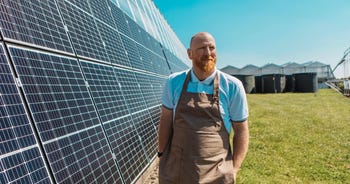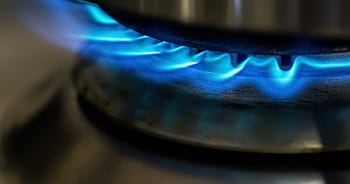The Climate Change Levy (CCL): What does it mean for small businesses?
The climate crisis is a global issue, and governments worldwide are reacting by introducing green initiatives and programmes and urging businesses and citizens to reduce their carbon footprint.
And to reduce our impact on the environment, the UK government introduced the Climate Change Levy over 20 years ago in a bid for businesses to reduce their energy consumption and become more sustainable.
But what exactly does this mean for small businesses? In this Bionic guide, we’ll walk you through everything you need to know about the Climate Change Levy and the simple changes your business can make to become more energy efficient.

30-second Summary
- The Climate Change Levy is an environmental tax that encourages businesses to have more sustainable practices. It's charged on energy usage - including lights, heating and anything that powers a business.
- There are two different rates - the main rate and the carbon price support rate. Most businesses that are required to pay CCL will pay the main rate, and how much you pay depends on energy usage. The standard 20% VAT rate is also applied to CCL payments.
- You only need to pay CCL if your business operates in these sectors - commercial, industrial, agricultural and public services. Some businesses that use a small amount of energy are exempt from paying CCL. Domestic users and charities are also exempt. Some businesses pay a reduced CCL rate, but only in certain sectors.
- You can also reduce your CCL rate by making your business more energy efficient. Start with an energy audit and then try the following: turn off all equipment at the end of the day, switch to energy-saving bulbs where possible, turn down thermostats, consider a smart meter and switch energy suppliers.
- Bionic can help arrange a new energy supplier for you or offer advice on switching.
What is the Climate Change Levy (CCL)?
The Climate Change Levy (CCL) is a commercial tax payment introduced in April 2001 in an effort to make UK businesses more sustainable. It aims to drive reductions in greenhouse gas emissions and encourage businesses to be more energy efficient in how they operate.
In theory, the more energy efficient your business is and the less carbon energy it uses, the lower CCL tax you’ll pay.
How is the Climate Change Levy charged?
The Climate Change Levy is charged on energy used for lighting, heating and power purposes such as electricity, petrol, natural gas and coal.
Business energy suppliers are responsible for charging CCL, as they supply the taxable commodities. Once the energy supplier has collected this CCL charge, it’s then passed on to HMRC (HM Revenue & Customs).
What are the current Climate Change Levy rates?
The CCL is split into two different rates — the main rate and the Carbon Price Support rate
Main rates
Any business that operates within the industrial, public services, agricultural or commercial sectors will be charged CCL at the main rate on electricity, solid fuel (such as coal) and gas.
The amount of CCL your business pays will depend on how much energy you use, as you’re charged per kilowatt hour (KWh) for gas and electricity and per kilogram (kg) for other fuels.
The previous and current main rates are:
| Year | Electricity | Natural Gas | Liquefied Petroleum Gas |
| 1st April 2020 to 31st March 2021 | 0.811p/kWh | 0.406p/kWh | 0.02175p/kg |
| 1st April 2021 to 31st March 2022 | 0.775p/kWh | 0.465p/kWh | 0.02175p/kg |
| 1st April 2022 to 31st March 2023 | 0.775p/kWh | 0.568p/kWh | 0.02175p/kg |
| 1st April 2023 to 31st March 2024 | 0.775p/kWh | 0.672p/kWh | 0.02175p/kg |
Carbon Price Support rate
The Carbon Price Support rate (CPS) is paid by owners of heat and power stations in a bid to reduce carbon emissions produced by businesses.
Businesses that generate some or all of their own energy — such as solar power or wind turbines — and make money selling the excess power back to the grid are typically classed as small generators and are exempt from the CPS rate.
The previous and current CPS rates are:
| Year | Gas | Petroleum Gas | Coal or Other Solid Fossil Fuels |
| 1st April 2015 to 31st March 2016 | 0.00334p/kWh | 0.05307p/kWh | 1.56860p/GJ |
| 1st April 2016 to 31st March 2025 | 0.00331p/kWh | 0.05280p/kWh | 1.54790p/GJ |
Who pays the CCL?
You’ll pay the main rate Climate Change Levy if your business operates within the following sectors:
- Industrial — These can be any businesses that make or sell machinery, equipment or supplies used in manufacturing and construction work. This includes factories, refineries and other large-scale production facilities.
- Commercial — The commercial sector encompasses businesses involved in providing goods and services, excluding industrial and public sector activities. This includes offices, retail stores, hotels and restaurants.
- Public services — The public services sector consists of government departments, local authorities, schools, hospitals, and other organisations involved in providing public services.
- Agricultural — The agricultural sector involves activities related to farming, cultivation, and the production of crops and livestock. It includes farms, nurseries, fisheries, and other agricultural enterprises.
Is VAT charged on the Climate Change Levy?
Yes, Value Added Tax (VAT) is charged on Climate Change Levy in the UK.
The standard 20% rate of VAT is applied to all CCL payments unless the supply is exempt or there’s a reduced rate of VAT in place. A business is exempt from VAT if they only sell VAT-exempt products — such as the selling, leasing and letting of commercial land and buildings, fundraising events by charities and more — or if they’re involved with taxable ‘business activities’.
Who is exempt from the Climate Change Levy?
Certain businesses may be exempt from paying the main rate of CCL, including:
- Businesses that use a small amount of energy. Less than 33kWh electricity and/or 145kWh gas a day.
- Domestic energy users such as homes, self-catering holiday accommodations and caravans
- Charities that engage in non-commercial activities. This means they don’t sell products or services to raise funds for their operations but instead rely solely on gifts and donations.
What happens if I think I’ve paid too much on the Climate Change Levy?
If you think that you’ve overpaid on the Climate Change Levy, then it’s possible to claim a tax credit.
Head over to the Gov.uk website and fill out the form to claim a tax credit.
How can I make my business more energy efficient?
If you’re looking for easy ways in which you can reduce your business's carbon footprint — and save money, too — then there are a few ways you can go about it:
Conduct an energy audit
First and foremost, the best way to kickstart your energy efficiency journey is by conducting an energy audit. This involves an examination of your business's energy use by either conducting one yourself or by hiring an outside body to perform one.
An audit can identify opportunities to save energy (and money!) that you might not have even considered!
To find out more about conducting an energy audit for your business, check out our guide.
Turn off equipment when not in use
This might seem like a no-brainer, but you'd be surprised how much energy is wasted by leaving equipment running when it's not being used. Remember to switch off your computers, lights, and other machinery at the end of the day. It might be a small action, but it can yield significant savings!
Looking to become more energy efficient in your office space? Our guide to business energy for offices has everything you need to know.
Change light bulbs to LEDs
Traditional bulbs can be a real energy drainer. Consider switching to energy-efficient lighting as it can use up to 75% less electricity compared to incandescent lightning.
LEDs can last a lot longer and consume significantly less energy. Plus, they offer the same, if not better, lighting quality!
Turn down the thermostat
If possible, try to keep your thermostats a few degrees lower in the winter and a few degrees higher in the summer. Essentially offices should be set to around 20 degrees, whilst 16 degrees is best for warehouses.
Additionally, you can consider programmable thermostats that automatically adjust temperature settings based on the time of day!
Consider a smart meter
Getting a smart meter installed in your business means you’ll be able to see exactly how and when you’re using energy.
It can help you identify patterns and understand which processes or equipment are using the most energy. This knowledge can help you to rethink your energy consumption.
Discover more about getting a smart meter for your business with our handy guide.
Switch energy suppliers
At Bionic, we make switching energy suppliers simple. We understand that every business is unique and has different needs when it comes to business energy, electricity, and gas contracts.
To start a business energy comparison and switch to one of Bionic’s trusted panel of suppliers, just give us your postcode, and our tech-enabled experts will use smart data to find an energy deal that suits the needs of your business.
How can my business pay a reduced rate on the Climate Change Levy?
Businesses can reduce their CCL payments by entering into a Climate Change Agreement (CCA) with the Environment Agency. A CCA is a voluntary arrangement that involves setting targets for increasing energy efficiency and reducing carbon dioxide (CO2) emissions. In return for meeting these targets, companies can receive a discount on the CCL.
To apply for a CCA, your business has to be part of an eligible sector, which typically includes energy-intensive industries. If you're eligible, you'll need to reach out to your sector association and ask them to set up a CCA on your behalf.
Here are the basic steps you would need to follow:
- Check your eligibility — Not all businesses can apply. You have to be part of a sector that is covered by a CCA. You can find the list of eligible sectors on the government's website.
- Reach out to your sector association — If you're eligible, contact your sector association. They can give you more information about the process and help you with the application.
- Set targets and make a plan — Together with your sector association, you will set energy efficiency or CO2 emissions reduction targets. You'll also create a plan on how you'll meet these targets.
- Submit your application — Once your plan and targets are in place, you can submit your application to the Environment Agency. If it's accepted, your business will be part of a CCA, and you'll get a discount on the CCL.
- Keep up with the targets — To keep receiving the discount, you have to meet the targets set in your CCA. This is usually assessed every two years.
Get your business set with Bionic
No matter the size of your business, even the smallest of changes can make a big difference.
If you need more help understanding business energy, head over to our energy guide pages for more information. Or, get in touch today with the Bionic team to discuss your business energy needs, including electricity and gas.








